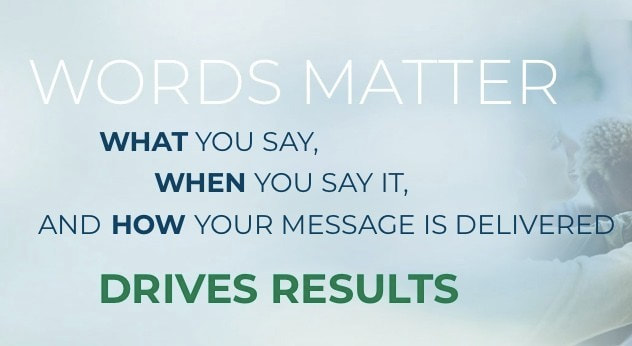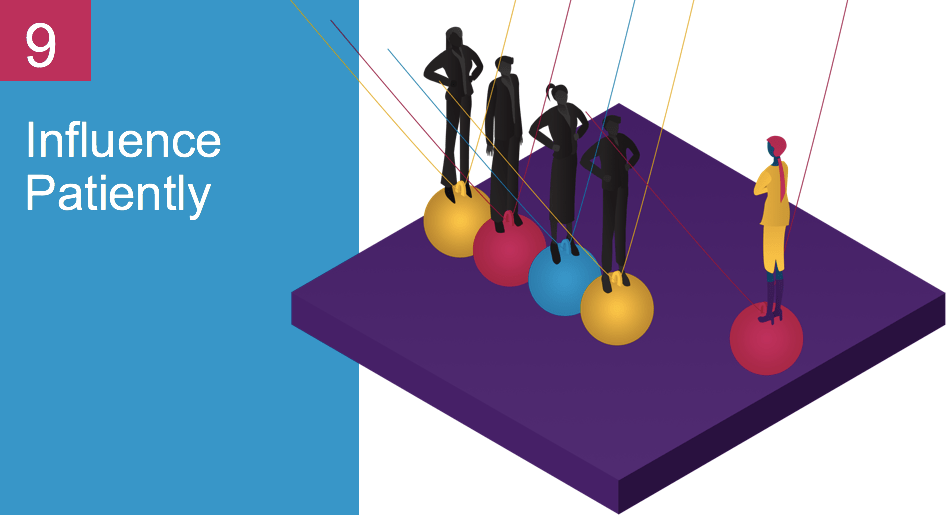When it comes to getting your ideas heard, the words you choose and your timing can make all the difference. So can using influence to bring people into your ideas. In part two of this blog (read part one), you’ll get practical tips on how to frame your ideas and build support for getting them adopted.
My motto is Words Matter. When it comes to expressing your ideas there are some words that you should never say. They shut people down. Don’t offer up an idea and add “that’s the way we always have done it”.
Another taboo is bringing up the name of the last company you worked for every time you offer up an idea. I know a man who spent decades as one of the top scientists at Dupont. When he joined the leadership team at a company I work with, he often got the eye roll because he prefaced his ideas with “When I was at Dupont.” It’s ok to reference your past experience. People value wisdom gained elsewhere. I do it by saying something like: “I remember considering a similar decision a few years ago.” Then I focus on the rationale and what I learned from the prior situation to set the stage for my recommendations.
Saying too many words doesn’t land well either. Have you ever heard someone make a suggestion that went on and on with a paragraph of preamble and so much description that the idea got lost in all the words? When you want to make a point, make your point. Then stop. Be as concise as possible. In our book Championing Science – Communicating Your Ideas to Decision Makers, we call this the practice of extracting the essence. It’s about finding the fewest possible words to make your point clearly. First you have to lay a foundation for understanding your idea. Later you can get into all the details. This can be especially hard for scientists who live in a world full of detail.
Sometimes getting your idea heard may best be accomplished by not saying it at all. Plant the seeds for your idea. Ask questions to help others arrive at the idea instead of just suggesting it outright.
Sometimes getting your idea heard may best be accomplished by not saying it at all. Plant the seeds for your idea. Ask questions to help others arrive at the idea instead of just suggesting it outright. There’s one more thing to consider. Sometimes it’s more important for your idea to get traction, than for you to get credit for the idea. When that happens, consider it a win. Choose your words carefully and take into account who is listening. People hear at many levels. The relationship level is a filter.
All of your past history with people colors the way they interpret what you say. When someone doesn’t seem to be listening, that may be because your words have landed in emotionally charged territory that shuts down their ability to hear. Think about performance reviews. And yes, this does happen at home a lot. Especially if you have teenagers! Hard conversations need neutral language. Use clear, simple, common language that doesn’t leave room for misinterpretation. When it comes to hard conversations, timing is everything.

Find a time when your listeners can be receptive. Finding the optimal time to express your ideas can improve your chances of success. Even for the simplest of ideas. I remember getting so frustrated with my daughter Alyssa – whose is now my wonderful 29-year old – when she was 14. The conversation would go something like this: “Good morning sweetie, why don’t you plan to be home by 3:00 today because you have an orthodontist appointment. She’d mumble ok. Twenty minutes later, she’d appear in the kitchen dressed and ready for school and have no memory of our conversation.
It took a while, but I finally learned that just because I’m wide awake and my brain is in gear first thing in the morning doesn’t mean the people that I love are ready for important reminders or conversations the minute they open their eyes. Still I bet if I had said I had a free afternoon and suggested taking her shopping for new jeans, she would have heard me!
Pick a time when your listeners can focus on what you want to discuss. It helps to ask specifically – do you have ten minutes to talk about an idea I’d like to share? Let them tell you when they want to have the conversations. Then be sure you get your listener’s engaged attention. Making eye contact will help you know that they are listening attentively.
Timing matters! Jumping in too soon can backfire, too. A few weeks ago, a client of mine was venting her frustration. She had made a recommendation that no one supported. Has that ever happened to you?
She works for a company with a promising new drug. She was at the table with four colleagues planning the agenda for an employee meeting. They were considering when to have the celebration of World Sickle Cell day. She eagerly recommended that they kick off the meeting with the celebration to get everyone inspired and motivated before diving in to the business updates. Good idea, right? No one agreed. The conversation continued and about ten minutes later, the woman who runs their patient advocacy programs, voiced the very same recommendation. This time, everyone agreed.
Why was she heard when my client wasn’t? Timing! And group dynamics. Everyone needs to settle into the topic of a meeting. That often takes a few minutes, especially if attendees have just come from a meeting on a totally different subject. My client raised her hand with the answer too soon.
You can imagine that she felt defeated and ignored. She may have been tempted to make a snarky comment like “I said that ten minutes ago”, but of course she knew better. If this happens to you, it’s so easy to just shut down. Instead, take a deep breath and learn from it. Reflect on your physical presence, voice and words and of course, your timing. And don’t let the situation keep you from voicing your ideas the next time.
What about timing when it comes to big ideas, the kind that you put into a proposal to a program sponsor or that become a major initiative. Big ideas need more time to get traction. In our book, Championing Science we outline 11 tenets. These are principles that we believe help you effectively communicate your ideas to decision makers. Principle #9 is Influence Patiently.

Influence is a process, not a one-time event.
Over the past seven years, I’ve watched my husband and co-author Roger influence patiently. He’s become very good at enlisting and uniting people inside and outside Lawrence Livermore Lab– thinking together how to solve the climate technology problem and fill the research gaps. He does that by establishing a shared sense of purpose. He builds coalitions and relationships by listening and understanding the capabilities that others can contribute. He invites people into the idea. Many scientists are good at advocating for ideas – explaining them with strong rationale, asserting them with confidence that their ideas are right. That style of influence is useful, too. But painting a vision that inspires others, can help you establish the environment where your ideas will be well received when you voice them.
So, the next time you have the opportunity to voice an idea, remember to think about your physical presence. Find your commanding voice, choose your words with your listeners in mind, consider your timing and influence patiently. And never forget that your ideas matter!



Leave a Reply